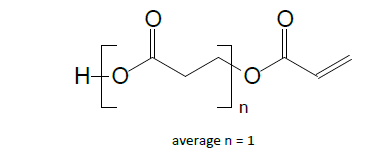Enhanced TDS
Identification & Functionality
- Blend
- No
- CASE Ingredients Functions
- Chemical Family
- Chemical Name
- Function
- Adhesion Promoter, Coupling Agent
- Product Code
- MITM00183
- Single Ingredient
- Yes
- Synonyms
- 3-(Acryloyloxy)propionic acid, 3-Acryloyloxypropanoic acid, Acrylic acid 2-carboxyethyl ester, Acrylic acid dimer, β-(Acryloyloxy)propionic acid, β-Carboxyethyl acrylate, β-CEA, β-Hydroxypropionic acid acrylic ester
- Technologies
- Product Families
- Chemical Structure

Features & Benefits
- CASE Ingredients Features
- Performance Highlights
β-CEA is characterized by
- Low color
- Moderate viscosity
UV/EB curable formulated products containing β-CEA are characterized by
- Good adhesion to a variety of substrates
- Low Tg The actual properties of UV/EB cured products also depend on the selection of other formulation components such as oligomers, additives and photoinitiators
Applications & Uses
- Coating End Applications
- Cure Method
- Product Applications
β-CEA is a diluent compatible with a wide range of acrylates used in UV/EB curing applications. Good adhesion to many different substrates makes β-CEA useful in a variety of overprint varnishes, inks, and coatings.
Properties
- Physical Form
- Soluble In
Packaging & Availability
Principal Information
- Group Principal Number
- S000001
- Principal
Storage & Handling
- Storage and Handling Conditions
Care should be taken not to expose the product to high temperature conditions, direct sunlight, ignition sources, oxidizing agents, alkalis or acids. This might cause uncontrollable polymerization of the product with the generation of heat. Storage and handling should be in stainless steel, amber glass, amber polyethylene or baked phenolic lined containers. Procedures that remove or displace oxygen from the material should be avoided. Do not store this material under an oxygen free atmosphere. Dry air is recommended to displace material removed from the container. Wash thoroughly after handling. Keep container tightly closed. Use with adequate ventilation.
Other
- Appearance
- Clear liquid
- Appearance (SDS)
- Clear to hazy liquid
- Color (SDS)
- Yellowish
- Flammability (SDS)
- Normal combustion
- IATA/ICAO Proper Shipping Name
- Corrosive liquid, acidic, organic, N.O.S.
- IATA/ICAO Technical name (N.O.S.)
- acrylic acid
- IATA/ICAO UN Number
- UN3265
- IMO/IMDG Proper Shipping Name
- Corrosive liquid, acidic, organic, N.O.S.
- IMO/IMDG Technical name (N.O.S.)
- acrylic acid
- IMO/IMDG UN Number
- UN3265
- Item Number
- Odor (SDS)
- Ester like acrylic
- Other Hazards
- Polymerization may occur from excessive heat, contamination or exposure to direct sunlight .
- Oxidizing Properties (SDS)
- None
- Protect from Freezing
- Yes
- TDG Canada Proper Shipping Name
- Corrosive liquid, acidic, organic, N.O.S.
- TDG Canada Technical name (N.O.S.)
- acrylic acid
- TDG Canada UN Number
- UN3265
- Temperature Control
- Yes
- USA/DOT Proper Shipping Name
- Corrosive liquid, acidic, organic, N.O.S.
- USA/DOT Technical name (N.O.S.)
- acrylic acid
- USA/DOT UN Number
- UN3265
- Chemical Properties
Value Units Test Method / Conditions Acid Value 342.2-375.9 mg KOH/g mg KOH/g Ester Value 6.4-7.0 meq KOH/g meq KOH/g Methoxyhydroquinone Content 900.0-1100.0 ppm ppm MEHQ - Optical Properties
Value Units Test Method / Conditions Color Scale max. 200.0 APHA APHA - Physical Properties
Value Units Test Method / Conditions Density 1.21 g/mL g/mL At 25°C Flash Point 87.0 °C °C Melting Point max. -35.0 °C °C Moisture Content max. 1.0 - Molecular Weight 144.0 g/mol g/mol Storage Temperature 39.0-104.0 °F °F Viscosity 70.0-100.0 - At 25°C - SDS Physical and Chemical Properties
Value Units Test Method / Conditions Boiling Point (SDS) min. 103.0 °C °C Flash Point (SDS) 87.0 °C °C Flash Point (SDS) 87.0 °C °C Closed Cup Melting Point (SDS) -47.0 °C °C Specific Gravity (SDS) 1.19 - Vapor Pressure (SDS) 11.6 - At 20°C Volatile Content (SDS) max. 0.1 - pH (SDS) 3.0 - - Shelf Life & Stability
Value Units Test Method / Conditions Shelf Life 0.0 -
